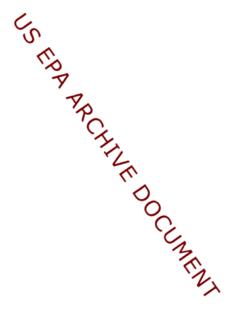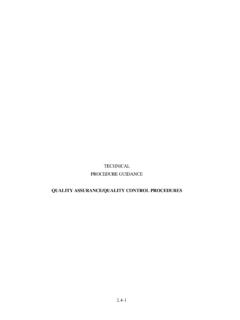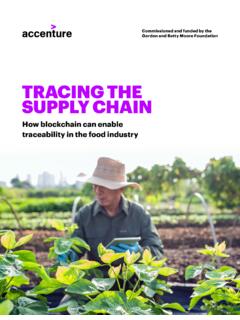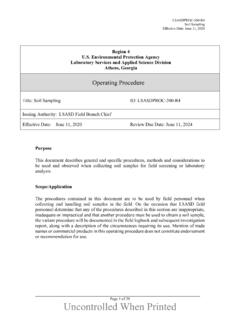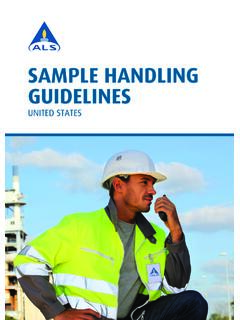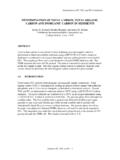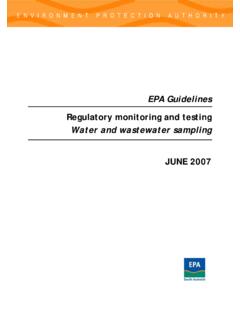Transcription of 8.0 Sample Handling and Custody
1 QA Handbook Vol II , Section Revision No: 1 Date: 12/08 Page 1 of 6 Sample Handling and Custody A critical activity within any data collection phase involving physical samples is the Handling of Sample media prior to sampling, Handling /transporting Sample media to the field, Handling samples from the field at the time of collection, storage of samples (at field or other locations), transport of samples from the field site, and the analysis of the samples. Documentation ensuring that proper Handling has occurred throughout these activities is part of the Custody record, which provides a mechanism for tracking samples through Sample collection, processing and analysis.
2 Custody records document the chain of Custody ; the date and person responsible for the various Sample Handling steps associated with each Sample . Custody records also provide a reviewable trail for quality assurance purposes and as evidence in legal proceedings. Prior to the start of an EDO, the various types of samples should be identified and the following questions asked: Does the Sample need to be analyzed within a specified time period? What modes of Sample transport are necessary and how secure should they be? What happens if a Sample is collected on Friday? Is the Sample shipped or stored at the field office and what are the procedures?
3 Can the Sample s integrity be affected by outside influences ( temperature, pressure, humidity, jostling/dropping during shipment, other influences) and do these need to be monitored ( , max/min thermometers, pressure sensors)? How critical is it that Sample integrity be known ( , is evidence tape necessary)? How can it be documented that Sample integrity was maintained from the collection to reporting? What are the procedures when Sample integrity is compromised ( , flag, don t analyze)? These are some of the questions that should be answered and documented in the monitoring organization s QAPP and SOPs. This section specifically addresses the Handling and Custody of physical environmental samples ( , exposed filters for particulate matter (PM) determinations and canisters containing whole air samples) that are collected at a field location and transported to a laboratory for analysis.
4 For specific details of Sample Handling and Custody ( , PAMS, NATTS, STN etc) monitoring organization should consult the appropriate technical assistance documents located in the National Programs summaries in Appendix A. In addition to physical samples, some types of field data collected in hard copy ( , strip charts, sampler flow data, etc.) or electronic ( , data downloaded from a data logger with limited storage space) format are irreplaceable and represent primary information about physical samples or on-site measurements that are needed to report a final result. When such hard copy or electronic data are transported and/or change Custody , it is advised that the same chain of Custody practices described in this section for physical samples be employed to ensure that irreplaceable data can be tracked and are not altered or tampered with.
5 For additional information, an EPA on-line self-instructional course, chain -of- Custody Procedures for Samples and Data1 is available for review. The National Enforcement Investigation Center2 (NEIC) also offers a course relevant to chain of Custody issues. 1 2 Comment [ALS1]: It sounded to me like Mr. Shanis had a specific course in mind, but I wasn t able to find one on chain of Custody . QA Handbook Vol II , Section Revision No: 1 Date: 12/08 Page 2 of 6 Laboratory Information Management Systems A laboratory information management system or LIMS, is a computer system used in the laboratory for the management and tracking of samples, instruments, standards and other laboratory functions such as data reductions, data transfer and reporting.
6 The goal is to create an EDO where: Instruments used are integrated in the lab network; receive instructions and worklists from the LIMS and return finished results including raw data back to a central repository where the LIMS can update relevant information to external systems ( , AIRNow or AQS). Lab personnel will perform calculations, documentation and review results using online information from connected instruments, reference databases and other resources using electronic lab notebooks connected to the LIMS. Management can supervise the lab process, react to bottlenecks in workflow and ensure regulatory demands are met.
7 External participants can review results and print out analysis certificates and other documentation (QA Reports, quality control charts, outlier reports etc.). For monitoring programs that are fairly stable, such as criteria pollutant monitoring, development of a LIMS system may be very cost effective and should be considered. There is an upfront cost in the development of these systems but monitoring organizations that have devoted resources to their development have seen pay offs in improved data quality, Sample tracking and data reporting. Sample Handling In the Ambient Air Quality Monitoring Program, discrete samples from manual methods associated with SLAMS, PAMS, NATTS, and other networks, are physically handled prior to analysis.
8 One must pay particular attention to the Handling of filters for particulate matter and lead since it has been suggested that the process of filter Handling may be the largest source of measurement error (especially low-volume methods). Due to the manner in which concentrations are determined, it is critical that samples are handled as specified in SOPs. The various phases of Sample Handling that should be documented in a QAPP and SOP include: Sample preparation, labeling and identification; Sample collection; transportation; Sample analysis; and storage and archival Sample Preparation, Labeling and Identification Sample containers or filters are cleaned and prepared (pre-weighing of filters) before being used to collect samples.
9 SOPs should indicate the proper care and Handling of the containers/filters to ensure their integrity. Proper lab documentation that tracks the disposition of containers/filters through preparation is just as important as the documentation after sampling. Care must be taken to properly mark all samples to ensure positive, unambiguous identification throughout the Sample collection, Handling , and analysis procedures. Figure shows a standardized identification sticker that may be used to label physical samples. Additional information may be added as required, depending on the particular monitoring QA Handbook Vol II , Section Revision No: 1 Date: 12/08 Page 3 of 6 program.
10 The rules of evidence used in legal proceedings require that procedures for identification of samples used in analyses form the basis for future evidence. An admission by the laboratory analyst that he/she cannot be positive whether he/she analyzed Sample No. 6 or Sample No. 9, for example, could destroy the validity of the entire test report. Any information that can be used to assess Sample integrity, such as the pressure of canisters or liquid level, should be recorded at the time of Sample collection. Liquid levels for samples in non-graduated containers can be marked on the side of the container with a grease pencil or permanent marker.











